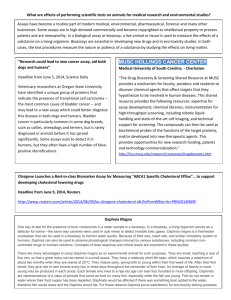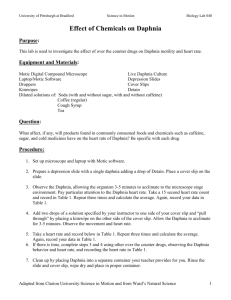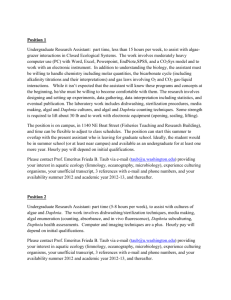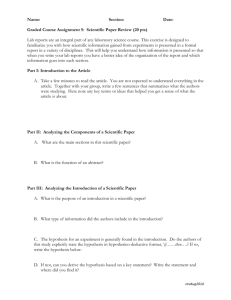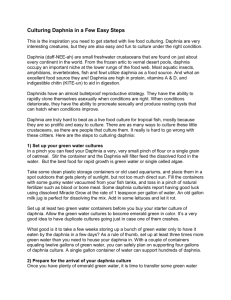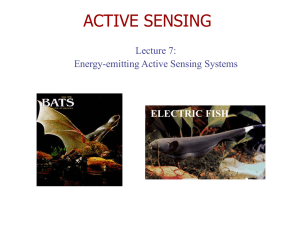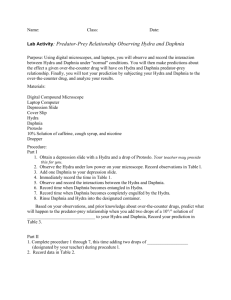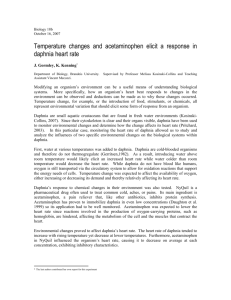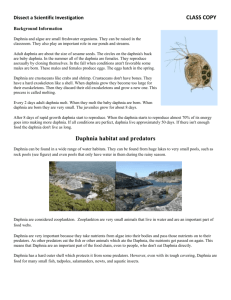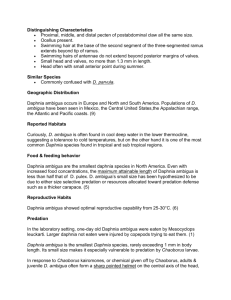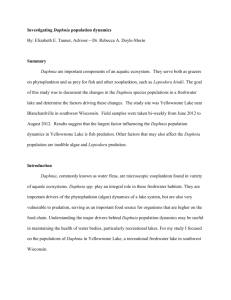Biology 11: Effects of treatments on Daphnia heart rate Pre-Lab
advertisement
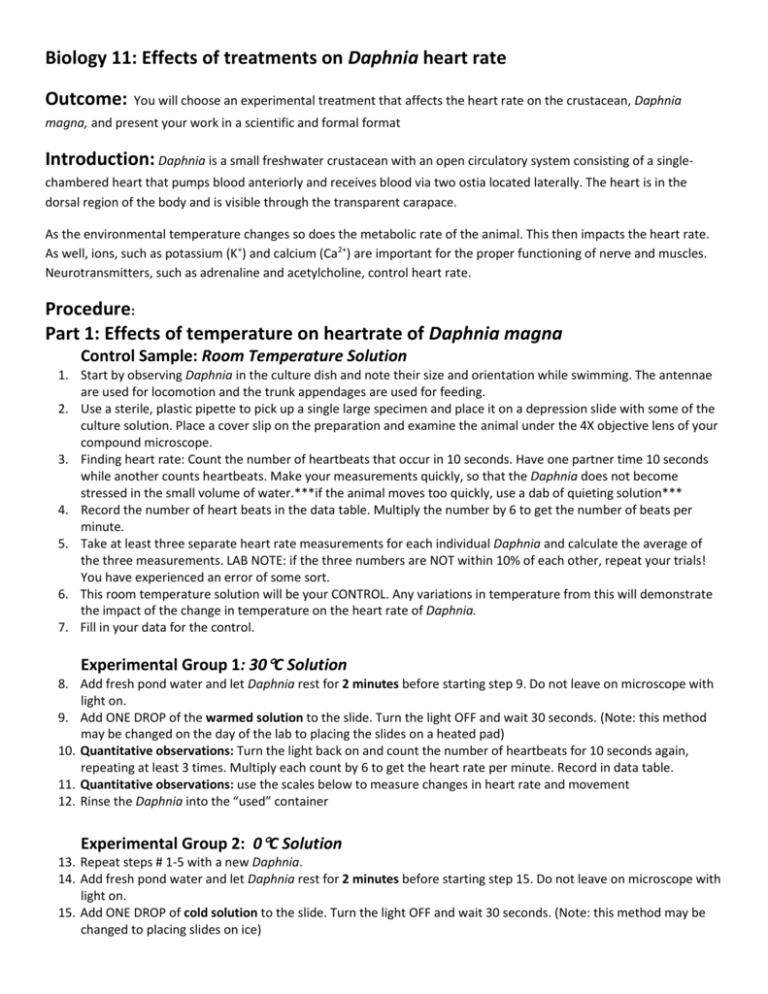
Biology 11: Effects of treatments on Daphnia heart rate Outcome: You will choose an experimental treatment that affects the heart rate on the crustacean, Daphnia magna, and present your work in a scientific and formal format Introduction: Daphnia is a small freshwater crustacean with an open circulatory system consisting of a singlechambered heart that pumps blood anteriorly and receives blood via two ostia located laterally. The heart is in the dorsal region of the body and is visible through the transparent carapace. As the environmental temperature changes so does the metabolic rate of the animal. This then impacts the heart rate. As well, ions, such as potassium (K+) and calcium (Ca2+) are important for the proper functioning of nerve and muscles. Neurotransmitters, such as adrenaline and acetylcholine, control heart rate. Procedure: Part 1: Effects of temperature on heartrate of Daphnia magna Control Sample: Room Temperature Solution 1. Start by observing Daphnia in the culture dish and note their size and orientation while swimming. The antennae are used for locomotion and the trunk appendages are used for feeding. 2. Use a sterile, plastic pipette to pick up a single large specimen and place it on a depression slide with some of the culture solution. Place a cover slip on the preparation and examine the animal under the 4X objective lens of your compound microscope. 3. Finding heart rate: Count the number of heartbeats that occur in 10 seconds. Have one partner time 10 seconds while another counts heartbeats. Make your measurements quickly, so that the Daphnia does not become stressed in the small volume of water.***if the animal moves too quickly, use a dab of quieting solution*** 4. Record the number of heart beats in the data table. Multiply the number by 6 to get the number of beats per minute. 5. Take at least three separate heart rate measurements for each individual Daphnia and calculate the average of the three measurements. LAB NOTE: if the three numbers are NOT within 10% of each other, repeat your trials! You have experienced an error of some sort. 6. This room temperature solution will be your CONTROL. Any variations in temperature from this will demonstrate the impact of the change in temperature on the heart rate of Daphnia. 7. Fill in your data for the control. Experimental Group 1: 30C Solution 8. Add fresh pond water and let Daphnia rest for 2 minutes before starting step 9. Do not leave on microscope with light on. 9. Add ONE DROP of the warmed solution to the slide. Turn the light OFF and wait 30 seconds. (Note: this method may be changed on the day of the lab to placing the slides on a heated pad) 10. Quantitative observations: Turn the light back on and count the number of heartbeats for 10 seconds again, repeating at least 3 times. Multiply each count by 6 to get the heart rate per minute. Record in data table. 11. Quantitative observations: use the scales below to measure changes in heart rate and movement 12. Rinse the Daphnia into the “used” container Experimental Group 2: 0C Solution 13. Repeat steps # 1-5 with a new Daphnia. 14. Add fresh pond water and let Daphnia rest for 2 minutes before starting step 15. Do not leave on microscope with light on. 15. Add ONE DROP of cold solution to the slide. Turn the light OFF and wait 30 seconds. (Note: this method may be changed to placing slides on ice) 16. Turn the light back on and count the number of heartbeats for 10 seconds again, repeating at least 3 times. Multiply each count by 6 to get the heart rate per minute. Record in data table. 17. Qualitative observations: use the scales below to measure changes in heart rate and movement 18. Rinse the Daphnia into the “used” container Part 2: Effects of Calcium and Potassium on the heart rate of Daphnia magna 1. Use a sterile, plastic pipette to pick up a single large specimen and place it on a depression slide with some of the culture solution. Place a cover slip on the preparation and examine the animal under the 4X objective lens of your compound microscope. 2. Finding heart rate: Count the number of heartbeats that occur in 10 seconds. Have one partner time 10 seconds while another counts heartbeats. Make your measurements quickly, so that the Daphnia does not become stressed in the small volume of water.***if the animal moves too quickly, use a dab of quieting solution*** 3. Record the number of heart beats in the data table. Multiply the number by 6 to get the number of beats per minute. 4. Take at least three separate heart rate measurements for each individual Daphnia and calculate the average of the three measurements. LAB NOTE: if the three numbers are NOT within 10% of each other, repeat your trials! You have experienced an error of some sort. 5. This “pure” pond water solution will be your CONTROL. Any variations in ion concentration from this will demonstrate the impact of the change in ion concentrations on the heart rate of Daphnia. 6. Fill in your data for the control. Experimental Group 3: Ca 2+solution 7. Add fresh pond water and let Daphnia rest for 2 minutes before starting step 8. Do not leave on microscope with light on. 8. Add ONE DROP of the CaCl2 solution to the slide. Turn the light OFF and wait 30 seconds. (Note: this method may be changed on the day of the lab to placing the slides on a heated pad) 9. Quantitative observations: Turn the light back on and count the number of heartbeats for 10 seconds again, repeating at least 3 times. Multiply each count by 6 to get the heart rate per minute. Record in data table. 10. Quantitative observations: use the scales below to measure changes in heart rate and movement 11. Rinse the Daphnia into the “used” container Experimental Group 4: K+ solution 12. Repeat steps # 1-5 with a new Daphnia. 13. Add fresh pond water and let Daphnia rest for 2 minutes before starting step 14. Do not leave on microscope with light on. 14. Add ONE DROP of cold solution to the slide. Turn the light OFF and wait 30 seconds. (Note: this method may be changed to placing slides on ice) 15. Turn the light back on and count the number of heartbeats for 10 seconds again, repeating at least 3 times. Multiply each count by 6 to get the heart rate per minute. Record in data table. 16. Qualitative observations: use the scales below to measure changes in heart rate and movement 17. Rinse the Daphnia into the “used” container Qualitative scales: Often it is difficult to count the heart rate of Daphnia. Thus we will also include a qualitative method of scoring the heart rate. The room temperature is the baseline and you will scale the changes in heart rate and movement according to the scales below. Heart rate 0 = stopped 1 = strong decrease 2 = decrease 3 = no change 4 = increase 5 = strong increase Movement 0 = no movement 1 = slight 2 = rapid 3 = very rapid Your Formal Lab: You’ll thank me for this in about 2 years (if you go into Biology/Sciences) Title: Accurately describes the contents of the paper and attracts reader’s attention using key words. You may use my title as a base but it should also include what treatments we specifically used Introduction: Includes general topic of the paper. Provides relevant background info on treatment. States the specific objectives of the study Describes any structural, functional, developmental, behavioural or ecological aspects of the organism being studied. Why are we using Daphnia This should be done formally and not in a conversational tone Don’t write predictions. SERIOUSLY- NO PREDICTIONS and don’t summarize the results/conclusion Methods: For this lab, you will not be required to complete this. But in a true formal lab it would be a detailed procedure of the experiment. Results: This will be the results sheet as provided by Ms. Roberts Discussion: Evaluate and interpret your results Refer to the biology of Daphnia in relation to the treatment. Do not use “I” “our” “we” This is a lab about Daphnia, not about you. Relate to previous experiments and contrast to predictions Include the following o Which solutions showed an increase in heart rate? o Which solutions showed a decrease in heart rate? o Did any solutions show NO change in heart rate? If yes, which ones? o Were any of your hypotheses correct? o Which solutions would you classify as a stimulant? o Which solutions would you classify as a depressant? Normally for a formal lab you’d be required to include references. I will provide you with some pre-selected papers and research. I will help you include these in your lab and write your references. To complete this lab we will be using the computer labs and I expect that you and your group use a shared Google document. Biology 11: Effects of treatments on Daphnia heart rate Pre-Lab: Use your group’s lab booklet to complete the following Name: _______________________ Date: ________________________ Use the introduction and research the following: Label the following (the internet knows all): Block: ______ Phylum: __________________________ Subphylum:____________________________ Scientific name: ____________________________________ Endoskeleton or exoskeleton: ______________________ What ions will be used in this lab? _______________________________________________________ Research the following: Out of calcium and potassium which plays a role in muscle contraction? Which plays an important role in transmission of nerve impulses? PROCEDURE CHECK: Read through the procedure and fill in the following 1. What is the control group in this lab? __________________________________________ 2. What are the experimental groups? ____________________________________________ 3. What are the dependent variables (the variables we measure)? 4. What are the independent variables (those which we manipulate)? 5. Make a prediction about each experimental group: Do not be concerned about being wrong, but do make a reasonable prediction using your understanding of biology. Procedure part 1: Effect of temperature Procedure part 2: Effect of presence of calcium and potassium 6. There are several precautions taken in this lab to make sure the results are not skewed. a. Why must you turn off the light while the before the heart rate is measured in each trial? b. Why must you let the Daphnia rest between measuring the control group and experimental groups’ heart rates? 7. List the apparatuses used in this lab. This should include equipment that will not be disposed of after the lab (non-consumable) 8. List the materials used in this lab. These are objects, solutions which are “consumed” during the lab. 9. Why do we use a qualitative scale as well as a quantitative scale? 10. Note that we are doing this lab in the formal style. This will be a major project (and your last one of Biology 11). Write down your group members’ names and email addresses below. You will create a Google doc. I’d like for you to share the address with me so that I can check on your progress and ensure the product is excellent. Biology 11: Effects of treatments on Daphnia heart rate Results: Name: _______________________ Date: ________________________ Block: ______ Observations: Write down some general observations about Daphnia in culture dish. Make note of their size and swimming orientation. Table 1: Effect of increased temperature on heart rate and movement of Daphnia magna Heart rate BPM Temperature Trial 1 Trial 2 Trial 3 Room Temperature Average _____ C 30C Qualitative Change: Heart rate Qualitative Change: movement Table 2: Effect of decreased temperature on heart rate and movement of Daphnia magna Heart rate BPM Temperature Trial 1 Trial 2 Trial 3 Room Temperature Average _____ C 30C Qualitative Change: Heart rate Qualitative Change: movement Table 3: Effect of calcium chloride on heart rate and movement of Daphnia magna Heart rate BPM Treatment Trial 1 Trial 2 Trial 3 Room Temperature _____ C Calcium chloride Qualitative Change: Heart rate Qualitative Change: movement Average Table 4: Effect of decreased temperature on heart rate and movement of Daphnia magna Heart rate BPM Treatment Trial 1 Trial 2 Trial 3 Room Temperature _____ C Potassium chloride Qualitative Change: Heart rate Qualitative Change: movement Average

